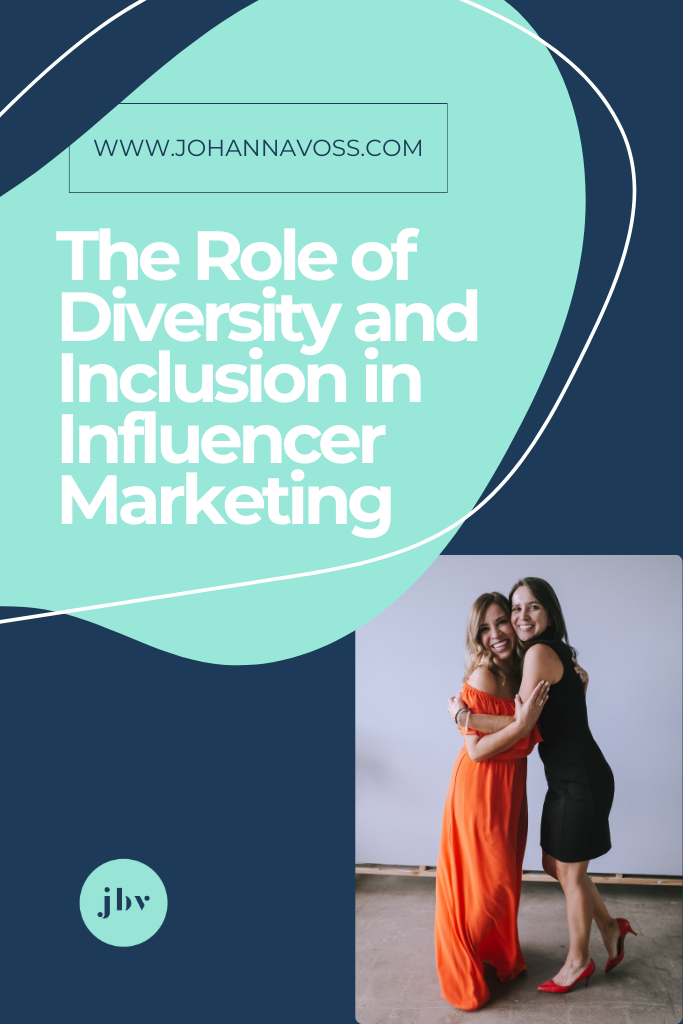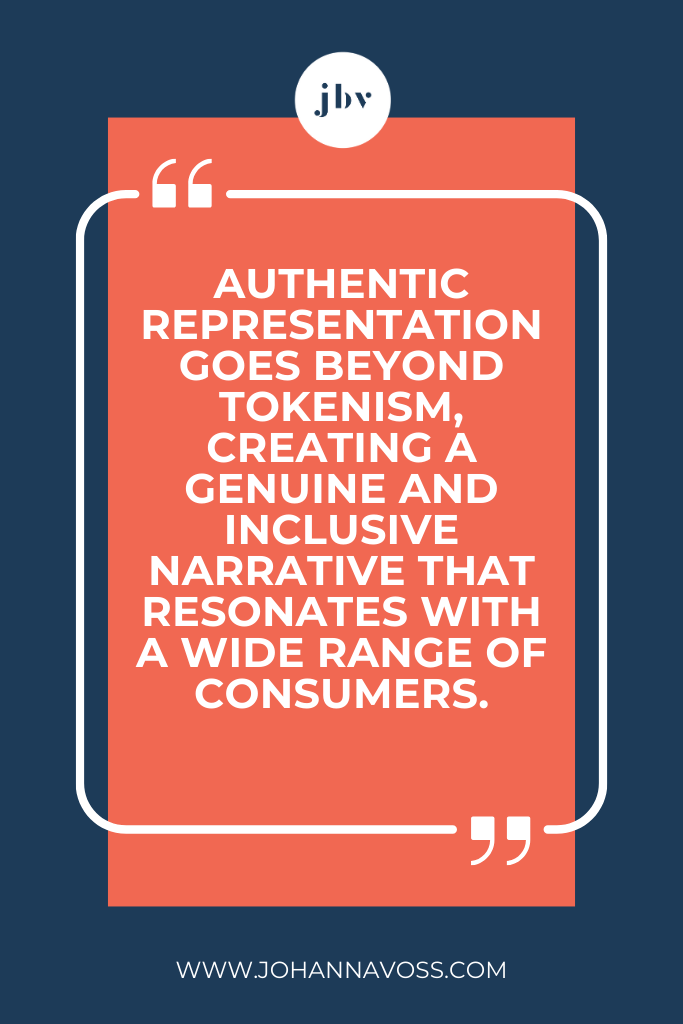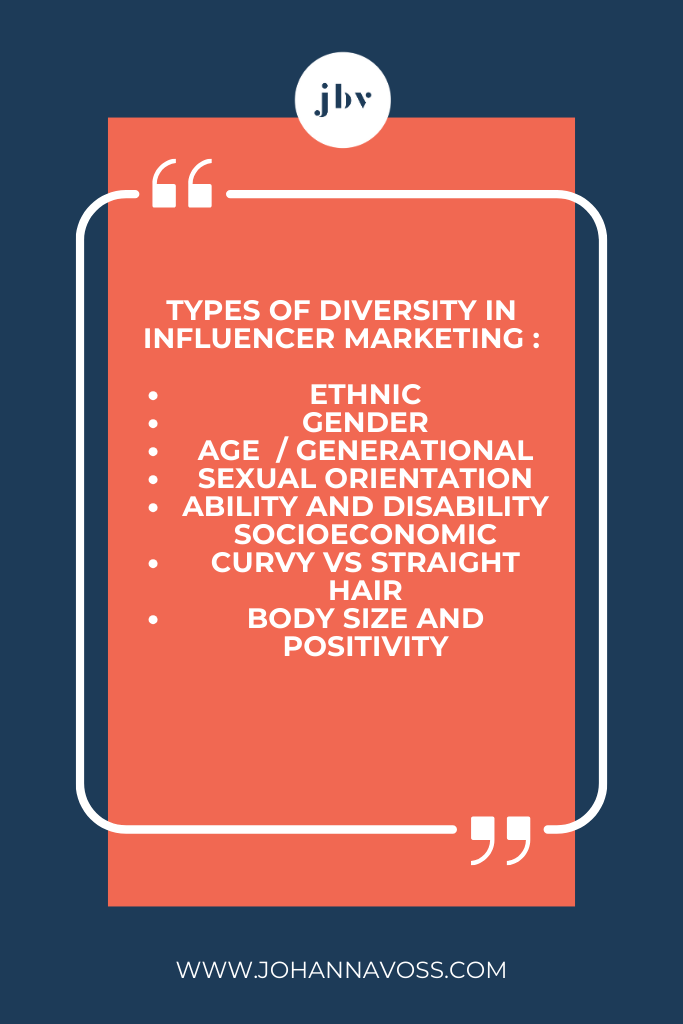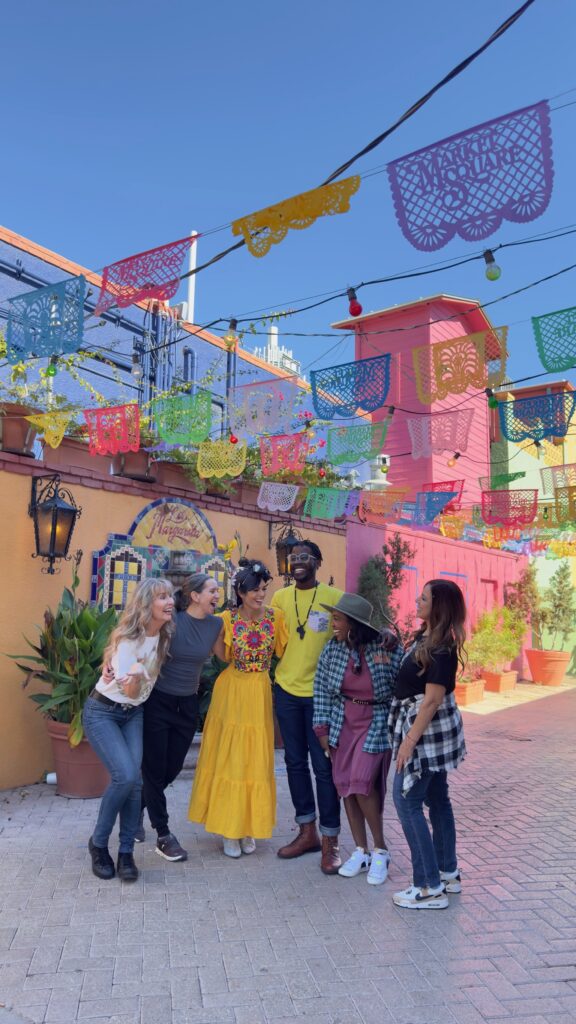The Role of Diversity and Inclusion in Influencer Marketing
In the ever-evolving landscape of influencer marketing, embracing diversity and inclusion is not just a trend; it’s a necessity. As brands strive to connect with diverse audiences, the influencer space fosters inclusivity and amplifyies underrepresented voices. In this blog article, we’ll explore the importance of diversity and inclusion in influencer marketing. Why does it matter more than ever?
It’s not just about ticking boxes for political correctness. It’s about recognizing that the world is a beautifully diverse kaleidoscope of perspectives and experiences. Brands that don’t embrace diversity and inclusion in all their marketing efforts, including influencer marketing, will soon be left behind.
Does it make me frustrated, angry and super annoyed that I’m even writing this article? Yes. Am I hopeful the industry will finally get it and embrace diversity as it should? Yes. Is it a long way off? Also yes.

What is influencer marketing?
Influencer marketing leverages the influence of individuals with substantial followings on social media platforms to promote products, services, or brands. At its core, it capitalizes on the trust and authenticity that you the influencer has cultivated with your audience.
These influencers, become powerful advocates for brands. You lend your credibility and personal connection to endorse products in a way that traditional advertising struggles to achieve.
The process of influencer marketing typically begins with brands identifying influencers whose values, aesthetics, and audience align with their own. This careful selection ensures a seamless integration of the brand message into the influencer’s content. This makes the promotion feel organic and authentic.
What makes Influencer Marketing work?
The effectiveness of influencer marketing lies in its ability to tap into the engaged and loyal followers of influencers. Audiences view influencers as relatable and trustworthy, and recommendations from these figures often carry more weight than conventional advertising. This approach is particularly successful in reaching target demographics that might be elusive through traditional advertising channels.
What role do influencers play in marketing?
Key to influencer marketing success is the cultivation of genuine relationships between influencers and their followers. Authenticity is paramount, and campaigns that feel forced or inauthentic can lead to a loss of trust.
Metrics such as engagement rates, reach, and impressions are crucial. They assess the impact of influencer marketing campaigns. Which in turn, helps brands refine their strategies for maximum effectiveness in this evolving and influential marketing landscape.
Why is diversity important in influencer marketing?
- Reflects Real-World Diversity:
In today’s globalized world, consumers are more diverse than ever. Embracing diversity in influencer marketing allows brands to mirror the diversity of their audience. When influencers represent various ethnicities, genders, ages, sexual orientation, and backgrounds, it sends a powerful message that the brand values and respects all its customers.
- Expands Audience Reach:
Different demographics are active on various social media platforms. By collaborating with a diverse group of influencers, brands can tap into niche markets and expand their reach. This not only increases visibility but also establishes a genuine connection with a wider array of potential customers.
Pro tip : Know where different parts of your audience hang out on social media. Not everyone is on all the platforms. There’s definitely a generational split across Facebook, Instagram and Tiktok.
- Builds Authentic Connections:
Authenticity is the cornerstone of successful influencer marketing. Audiences are becoming more discerning, craving genuine connections with the brands they support. Diverse influencers bring unique perspectives and relatable stories. This fosters a sense of authenticity that resonates with followers and enhances the brand’s credibility. The best marketing is one when you know the brand is speaking directly to YOU, not someone else.
- Addresses Underrepresented Narratives:
Inclusive influencer marketing provides an opportunity to address and rectify historical underrepresentation in media. Brands that actively seek out influencers from marginalized communities contribute to the dismantling of stereotypes. This helps to promote a more inclusive narrative in the digital sphere. Everyone wants their story told and to be seen.
- Cultivates Brand Loyalty:
When consumers see their values reflected in the influencers a brand collaborates with, it fosters a sense of loyalty. Inclusive marketing strategies show that a brand is aware of and responsive to the diverse needs and perspectives of its audience. All of this strengthens the emotional connection between the brand and its customers. Customers who see themselves in a brand’s marketing are more likely to be loyal to that brand.
- Meets the Expectations of the Modern Consumer:
Modern consumers are socially conscious and expect the brands they support to share their values. Demonstrating a commitment to diversity and inclusion in influencer marketing aligns with these expectations, enhancing a brand’s reputation. Thus making it more appealing to a broader audience.
Customers also expect the brands to do better because they can and they should. A customer can see right through a brand someone of color or from a marginalized group is being tokenized.
- Stays Ahead of the Competition:
In a competitive market, differentiation is key. Brands that lead the way in embracing diversity and inclusion set themselves apart from competitors. This proactive approach attracts a diverse customer base and positions the brand as a thought leader in the industry.
Pro tip : When a customer or client of your brand sees themself in the marketing & promo materials, it builds a deeper trust and connection to your brand.
And don’t forget, the opposite is true. A customer or client of yours who doesn’t see themselves in your marketing on the website or social media, will be turned off. It might even encourage them to seek out a competitor who does feature faces, people & stories that they can relate to.
Authentic representation goes beyond tokenism, creating a genuine and inclusive narrative that resonates with a wide range of consumers.

From a business perspective, embracing diversity in influencer marketing isn’t just the right thing to do, it helps a business’ bottom line (and let’s be honest, that’s what 99% of businesses care about!).
Diversity in influencer marketing opens doors to untapped markets and demographics. By engaging influencers from different backgrounds, brands can access niche audiences that might otherwise be overlooked.
In the era of social consciousness, consumers are increasingly drawn to brands that champion diversity and inclusion. Brands that prioritize these values in their influencer marketing campaigns not only align with the expectations of socially conscious consumers but also contribute positively to societal conversations. It’s a powerful way for brands to demonstrate their commitment to social responsibility and ethical business practices.
Ultimately, embracing diversity and inclusion in influencer marketing is not just a trend but a strategic imperative. It enhances brand authenticity, expands audience reach, and aligns businesses with the values of an increasingly diverse and socially aware consumer base
Types of diversity in Influencer Marketing:
- Ethnic diversity
- Gender diversity
- Age diversity / generational representation
- Sexual orientation representation
- Ability and disability representation
- Socioeconomic diversity
- Curvy vs straight hair representation
- Body size and positivity representation

What does diversity and inclusion look like in Influencer Marketing?
- Diverse Influencer Representation:
Collaborate with influencers who authentically represent various cultures, ethnicities, genders, abilities, and backgrounds. By featuring influencers from different walks of life, brands can ensure their messages are relatable and culturally sensitive. As the brand, you must think beyond just skin color. You need diversity of ages, generations, hair type, county of origin, sexual orientation, gender and language for starters.
- Cultural Competence and Sensitivity:
Brands must invest time in understanding the cultural nuances of the audiences they aim to reach. Brands shouldn’t presume to know what’s important to a certain group of people. Nor should they ever change someone else’s personal stories and anecdotes.
Pro tip : If you want to run a diverse influencer marketing campaign, you must have diverse voices on the team running the campaign. A brand should NOT have an all white or all straight staf, run a campaign for Hispanic Heritage or Pride month.
- Localized Content and Language:
Tailoring content to specific cultural contexts and languages is crucial. Influencers who create content in the language and style that resonates with their audience can break down communication barriers. This will make the brand message more accessible. The Spanish spoken in Mexico is different to the Spanish spoken in Chile which is different to the Spanish spoken in Argentina. Got it?
- Showcasing Diversity in Campaigns:
Actively incorporate diversity into influencer marketing campaigns. Highlighting various perspectives and lifestyles fosters inclusivity. It also demonstrates a commitment to representing the diversity of the audience. This literally means have diverse faces, people and backgrounds showcased in your marketing – on your website, promotional materials and social media. As a white, straight, cis-gendered woman, I want to scroll your Instagram feed and see different people looking back at me.
- Collaborative Storytelling:
Encourage influencers to share personal stories that reflect their cultural backgrounds and experiences. Storytelling is a powerful tool that can create emotional connections and foster understanding across different cultural groups. Remember, all stories make a brand’s marketing personal and all marketing and selling is personal. - Celebrating Cultural Events and Festivals:
Aligning campaigns with cultural events and festivals is an effective way to engage diverse audiences. Influencers can share content related to celebrations, traditions, and cultural moments, creating a sense of shared experience.
A word of warning to a brand who is choosing to link up a cultural event to their marketing, ensure you are not taking advantage of the event. It’s very easy to sniff out when a brand is riding the coattails of a culture or underrepresented people.
Pro tip : Allow the people who celebrate that cultural event to lead the way on how the celebration happens. Don’t presume to know or tell them how it’s done.
- Engaging in Conversations:
Foster dialogue between influencers and their followers from diverse backgrounds. Encourage discussions around cultural topics, invite input, and actively listen to the feedback to create a two-way conversation. Respectfully join in the conversation.
Pro tip : When trolls hit back at the influencers that you hired for a campaign, (because we all know nothing brings out a nameless troll like a diverse marketing campaign), ensure you have the influencer’s back. When your influencer partners are getting dragged on social media because they “aren’t Mexican enough” or “that’s not how it really happens in China”, defend the Influencer and block the troll.
- Be open minded
When working on a diverse influencer campaign, the brands need to remember, they aren’t the expert. Be humble. Have open ears & eyes. Ask questions. Convey that you’re open to learning and having the influencer take the lead on cultural sensitive topics. Learn from your influencer partners.
- Diversity in the campaign materials
Diversity in Influencer Marketing isn’t just limited to the campaign or the staff. Diversity in influencer marketing also extends to the brief that is sent to the influencer ahead of content creation. The brief must also include diverse images, messaging, examples and references.
Pro tip : Diversity isn’t just and only done with words. In order for a brand’s authentic commitment to diversity to ring true, it has to extend beyond the words said to an influencer when recruiting them for a campaign.

This means in printed marketing materials for a hotel property, adventure park or destination. This means on a company’s website and across their social media. This means on the influencer campaign marketing calls with the brand or agency team as the campaign unfolds.
Brands don’t realize just how evident it is when they are only giving lip service to their commitment of diversity. Influencers & consumers alike are smart and savvy. They (we) are all paying attention to where, how and when brands are showing up. I know I’m paying attention and I’m pretty sure you are too!
We see you when you only want to work with Latinas during Hispanic Heritage month or with Black creators in February. We’ll take your money but it’s disgraceful when the brands tokenize diversity and expect to capitalize on it. Lip service won’t get you very far around here. Influencers will hold brands accountable as unfortunately they need to do. Brands have done a lot of performative marketing and we’ve lost trust (did we ever have it?) that brands will do the right thing.
Work with diverse Influencers
As a brand you may want to know, where can I find more diversity of talent for my campaigns? Good, about damn time!
As an Influencer talent manager for a roster of talent that’s diverse and multicultural, I’ve got you boo!
- Create a broad, wide diverse talent pool from which to hire diverse influencers.
BEFORE the brand’s campaign starts, ensure you have a large list that goes both wide and deep of multicultural and diverse influencers that you’re familiar with. Build out this list ahead of time. Always be on the lookout for creators to bookmark and pay attention to. Ensure when you’re looking at a database for talent, your search terms aren’t somehow filtering out diverse talent. Don’t see diverse faces coming back in your search? Keep looking and reach out to the platform to ensure they highlight diverse creator profiles. - Use hashtags
Using hashtags is a great way to find more creators that aren’t on a brand’s radar yet or that a brand may be overlooking when searching a database. #latinacreator #blackfoodblogger are two places to start. - Hire a diverse staff
Embracing diversity and inclusion in influencer marketing doesn’t only mean the brand is hiring a diverse slate of influencer partners for campaigns. It also means the agency or company that is running the campaign has a diverse staff. - Engage current loyal brand fans
Don’t overlook the content creators that already use, love and tag or mention the brand in their content. You don’t need to convince them to try the brand or product when they are already converted! - Lean on Talent Managers
Us talent managers are a very overlooked resource when it comes to sourcing more diverse talent for a campaign. I for one, have a full roster of diverse, multicultural and multilingual and multigenerational talent from all walks of life. This is my roster that I’m very proud of. And I have a very strong network of other influencer talent managers that I lean on and share casting calls.
I wrote this article for an Influencer who wants to find an Influencer Talent Manager but the same tactics to find one apply, if you work agency side and need to expand your network. Hit me up and I’ll help you out.
- Use the Google or Linkedin.
Use the google for questions like “Top Latina Food blogs” or “Top Latina travel influencers” to find creators you don’t already know. Posting calls for diverse talent on LinkedIn, leaning on your network of other agency reps, creators and Influencer talent managers is also incredibly helpful. Tag me when you post on Linkedin or IG. ! I’ll always do what I can to bring new people to your talent pool.
- Reach out to Past campaign partners
Look back at past campaign partners, (hopefully they’re diverse), and go thru who they follow, like and trust on different social media platforms. No doubt amazing Black Food bloggers will lead you to so many other Black food bloggers! You have to spend some time on this to search and go down some social media rabbit holes.

The question arises: “What are the best practices for ensuring genuine inclusion in influencer campaigns?” The answer is to foster meaningful partnerships that extend beyond the transactional. Create an open dialogue with influencers, valuing their input, and collaboratively developing content that authentically represents their unique perspectives.
Utilizing diverse influencers in strategic roles, such as brand ambassadors or contributors, amplifies their influence and signals a commitment to inclusivity. By consistently prioritizing authenticity and embracing diversity as a core principle, brands can forge genuine connections, break down stereotypes, and contribute to a more inclusive digital landscape
Influencer Marketing diversity challenges
While the pursuit of diversity is commendable (and the right thing to do), it is not without its challenges. One common issue involves potential tokenism, where brands may engage influencers solely based on their diverse backgrounds without a genuine commitment to inclusivity.
As an influencer talent manager who represents a number of Latina talent, I see this every year when brands reach out (usually last minute) to partner with us for Hispanic Heritage month. Usually the request comes with some messaging that the brand is excited to partner with a Latina to showcase their product & shine a spotlight on them blah blah blah.
Am I jaded? Yes. Because it’s a last minute request, it often doesn’t come with budget or minimal budget at best and the brands act like they just heard of Hispanic Heritage Month. It’s September 15 – October 15 every damn year.
Actually, in my world, every month is Hispanic Heritage Month.
The 2 best things any brand can do to display their commitment to diversity is
- Put their money where their mouth is. Pay creators and pay them well. Also, hire a diverse staff.
- Be consistent, year round with diversity and inclusion in their Influencer Marketing.

Another challenge lies in navigating cultural sensitivities, as brands must be cautious not to perpetuate stereotypes or engage in cultural appropriation inadvertently.
It is essential to establish clear and transparent communication channels with influencers. This includes open dialogues about expectations, mutual goals, and an understanding of the influencer’s values. Learn from the Influencers that you’ve hired for your campaign. Before you get into the campaign details, learn their story, personal connection to the brand/dish/cultural event.
A mistake brands can avoid when looking at content for approval, is do NOT edit or change the Influencer’s personal story or anecdote. Can a brand edit to ensure adherence to the brief? Yes. But can a brand edit content because they don’t like the way the story was told? No.
As an Influencer talent manager, I have many examples of when a brand has edited my talent’s personal story about how they celebrate an occasion or a recipe their grandmother used to make. I’ve got more examples when a brand used google translate to check the Spanish translation of content and edits content of my talent (who speaks Spanish as their first language) and suggest changes.
I can also VERY easily show you what a diverse campaign could look like. In the photo below, which is 5 of my clients and I, we have ethnic, language, age/generational & hair type diversity.

The pivotal question emerges: “What steps can brands take to address challenges and controversies related to diversity in influencer marketing?” The solution lies in cultivating a culture of awareness and sensitivity. Brands should invest in diversity training for their marketing teams, fostering a deep understanding of the nuances associated with different cultures and backgrounds.
Additionally, actively seeking feedback from both influencers and the audience can provide valuable insights, helping brands adapt and refine their strategies in response to evolving societal expectations. By navigating these challenges with empathy, transparency, and a commitment to continuous improvement, brands can contribute meaningfully to the promotion of diversity in influencer marketing.

Benefits of diverse Influencer Marketing for brands
It’s simple. You will build & strengthen your customer base and their loyalty. And we all know what that’s good for…..a company’s bottom line.
There is no downside to embracing diversity and inclusion in Influencer Marketing.
In conclusion, the role of diversity and inclusion in influencer marketing extends far beyond a mere trend—it is a dynamic force shaping the future of digital engagement. Embracing influencers from various backgrounds, ethnicities, genders, and lifestyles is not just a strategy; it is an imperative for brands seeking genuine resonance with diverse audiences.
By prioritizing authenticity, fostering meaningful connections, and navigating potential challenges with sensitivity, brands can harness the power of diverse voices to amplify their reach and influence. As they should!
As the influencer marketing landscape continues to evolve, integrating diversity and inclusion into strategies not only reflects the pulse of societal expectations but also propels brands toward a future where authenticity and inclusivity are central tenets of digital influence.
Pro tip : If you’ve loved this article, sign up for my weekly newsletter HERE. It’s full of industry insights, brand negotiation tips and scripts, events I’m attending, perspective on how to grow your Influencer business and more. I keep it pretty scrappy and real – would love you to join us over there! CLICK HERE TO SIGN UP.
